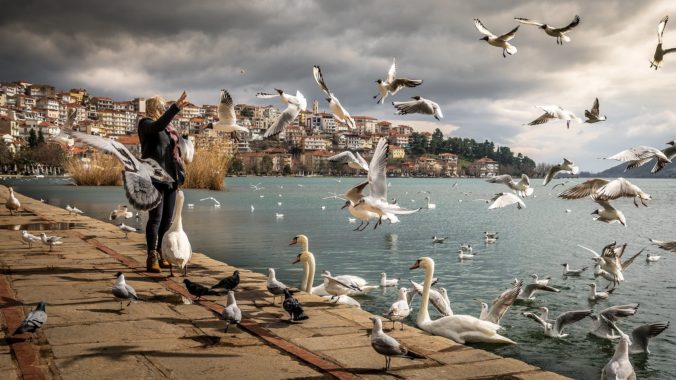Bizarre animal, mineral, and human behavior in The Birds and Picnic at Hanging Rock. By Kevin Rush
Halloween is finally in the rearview mirror, but we can still talk about eerie goings on that capture our cinephile imaginations. Today, two haunting tales of enigmatic terror.

In this droll, long-winded trailer, Alfred Hitchcock sets up the premise of his 1963 film, The Birds. We’ve feasted on them since the beginning of time, and now they’re set on revenge. Chickens coming home to roost, one might say. Of course, that’s just conjecture, since none of the angry avians are of the speaking variety. Where’s a magpie when you need him? Maybe we shouldn’t have killed that mockingbird.
Hitchcock’s last great film was a first for his leading lady, Tippi Hedren. Since Princess Grace had retired from pictures in 1956, Hitchcock had run through a gamut of blonde actresses, earnestly searching for a suitable replacement. Doris Day, Kim Novak, Eva Marie Saint and Janet Leigh gamely faced various perils, but were not invited back. Then Hitchcock spotted Hedren in a soda commercial and signed her to a seven-year contract. Melanie Daniels was Hedren’s first credited role at 33, well past the debutante age, especially for a Hollywood starlet. She would have a long career, but would only make one more film with Hitchcock, Marnie in 1964.

The Birds employed various techniques to get the attack scenes right, including hand-puppets, mechanical birds and live, trained birds, reportedly fed whisky-soaked wheat to make them docile. The birds’ flapping made traditional blue-screen filming impossible, so the company had to employ a sodium vapor process to do the composites. The only studio equipped to manage the process was Disney, so a deal was struck to do filming there. The decision paid off, as The Birds was nominated for the Special Effects Oscar, but lost to the overpriced box office dud, Cleopatra. It was the last Oscar nomination for a Hitchcock film.
The source for The Birds was not a novel, but a short story by Daphne du Maurier, whose novel Rebecca had inspired Hitchcock’s only Best Picture Oscar-winner. The story is set in a coastal village in England and concerns the efforts of a laborer to save his wife and two young children from the inexplicable attacks. Cut off from the rest of the world, they seek the means to survive on their own. The story is chilling, and had caused a stir when it was released in 1955, sparking TV and radio adaptations. Hitchcock immediately purchased the film rights, though he didn’t consider making the movie until a bizarre seabird attack on the coast of California revived his interest.

The story has no characters in common with the film. And Hitchcock moves the setting to Northern California, no doubt to appeal to American audiences and to capitalize on any free publicity that references to the seabird attack might generate. Hitchcock’s film also departs from du Maurier’s story in his suggestion of the birds’ revenge motive. In du Maurier’s story, townsfolk note the bitterly cold weather as a cause for strange migration patterns. Something has gone on in the arctic, and it’s suggested the Russians might be behind it. Written during the Cold War, du Maurier’s story could be seen as a paranoid fantasy or a warning about Communist aggression. Could they actually turn nature against us?
Hitchcock went out of his way to make his film apolitical: the fault, if any, lies with all of humanity, the way we treat the planet and the lesser species in it. Of course, today, that angle is thoroughly politicized…with noticeable undertones of Communism. Or maybe that’s just this writer’s paranoid fantasy. At forty pages, du Maurier’s story is worth a read on a cold, windy night.
On St. Valentine’s Day, 1900, students from a girls’ school in Victoria, Australia enjoy an annual field trip to an odd rock formation, where two of the girls and a teacher mysteriously vanish. The fallout from that event and its effects on the school and various characters involved in search and recovery form the basis for Peter Weir’s 1975 film Picnic at Hanging Rock.

That picture put the Australian director on the map and set him up for stellar success in the 1980s with hits such as Gallipoli, Witness and Dead Poets Society. In Hanging Rock, Weir, who has expressed his preference for the mystery over its solutions, paints a picture of a repressed society where man is so artificially separated from nature that nature itself revolts to reclaim its own.
From its ethereal opening, infused with the primitive, otherworldly notes of a tin whistle, Weir goes out on a limb to suggest a paranormal explanation for the disappearances at the eponymous volcanic formation. The result is a very ‘70s cinematic experience that tends to overshadow the human drama of those left behind.

By contrast, Joan Lindsay’s 1967 novel (the author’s first at the age of 70!) is more restrained. Part reportage, part comedy of manners, part social criticism, and part procedural mystery, Lindsay’s story unfolds deftly and patiently. (Lindsay is much more patient in the telling than I was in the reading, devouring several chapters at a time.) Yet, roiling below the surface is a suspicion that something evil this way has come. Is it black fate or human frailty that brings cascading tragedy? Lindsay knows better than to intrude on her readers’ internal debate. Artful and delicious throughout, it’s a novel well worth discovering.
Disclaimer: This post may contain affiliate links. When you click on the link, the author receives a small commission on purchases for a limited time at no additional cost to you. These commissions help ensure future posts. Thank you.






Leave a Reply
You must be logged in to post a comment.